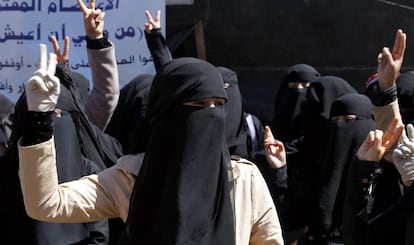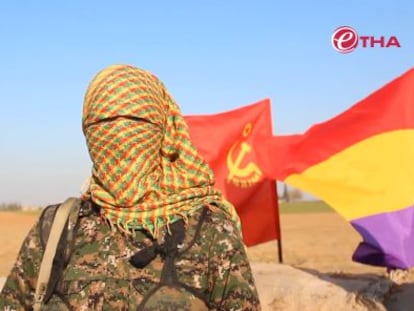Asphyxiated Arabs
In three years it will be necessary to create 60 million jobs for young people in the region

The 22 countries that make up the so-called Arab world represent only 5% of the global population, yet they account for 68.5% of the world’s deaths from armed conflict, 57.5% of refugees, and 45% of terrorist attacks (2014 figures).
These are some of the appalling realities documented by the United Nations Development Programme’s (UNDP) report on Human Development in the Arab World.
Young Arabs have the highest unemployment rate in the world
Surprisingly, the focus of this report is not war. It is young people. And it is very appropriate that it be so. Two-thirds of the Arab population is under 30 and half of them are between 15 and 29 years old. It is the group with the highest unemployment rate in the world, and among them, those with the poorest job prospects are women. The global unemployment rate for young women is 16%. In the Arab countries it is 47%. According to the World Bank, over the next three years the Arab countries would need to generate 60 million new jobs to absorb all the men and women who will be seeking employment for the first time. The UNDP report explains that the problem is not only that the Arab economies do not generate enough jobs, but also that their education systems, which are among the worst in the world, do not give young people the knowledge to navigate successfully in today's world or the skills they need to find work.
But while the economies and education systems are not doing well, armed conflicts are booming. Currently 11 of the 22 Arab countries are at war. Moreover, the vast majority of the Arab population has recently suffered an armed conflict, still suffers from one, or has a high risk of being involved in one. Of the 350 million people living in that region, 70 million are in Sudan, Yemen, and Somalia. Another 67 million live in Syria and Iraq. Thus, between 1988 and 2014, military expenditures in the region increased by two-and-a-half times, and per capita expenditure on arms became 65% higher than the world average. Since 2009 it has increased 21%.
In short, the Arab Human Development Report not only highlights the devastating impact of armed conflict on young people, but it also documents the few economic opportunities they have, the defective health and education services they receive, the widespread discrimination against women, and the limitations that young people have to participate in politics and, thus, channel their desires for social and political change. This final point is a critical factor that feeds the frustrations and hopelessness that, according to the report, prevail among young Arabs. For most of them a real future only exists outside their country.
While the economies and education systems are not doing well, armed conflicts are booming
It is important to note that the first of these UNDP reports on the situation of the Arab countries was published in 2002 and broke two traditions: The first was that previous studies on the region had predominantly been carried out by foreign experts. The second was that the automatic response of politicians and opinion makers from the region was to blame the rest of the world. In contrast, since that first report in 2002, the custom has been for a group of respected Arab experts to offer a new perspective every year on the problems and their possible solutions. The authors do not doubt that many of the tragedies of the Arab world are caused by the aftermath of colonialism, imperialism, the Cold War, and the armed interventions of the United States and Europe that overthrew dictatorships in Iraq and Libya, for example. And they also know that the foreign powers subjected – and continue subjecting – the region to their own interests and conflicts. But the novelty of these reports is that they recognize that many of the problems of the region are not imported, but homemade. And that, therefore, they can be alleviated by changing some of the conditions that are not the result of foreign influence, but that originated locally. One of the great merits of these analyses is their pragmatism.
But pragmatism can be a double-edged sword. As is the case with all the work of international agencies, there are issues that this UNDP report prefers, pragmatically, to ignore. Perhaps the most important is the impact on millions of young Arabs of predatory dictatorships and corrupt monarchies that suffocate them and rob them of their future.
Follow me on Twitter @moisesnaim.
Tu suscripción se está usando en otro dispositivo
¿Quieres añadir otro usuario a tu suscripción?
Si continúas leyendo en este dispositivo, no se podrá leer en el otro.
FlechaTu suscripción se está usando en otro dispositivo y solo puedes acceder a EL PAÍS desde un dispositivo a la vez.
Si quieres compartir tu cuenta, cambia tu suscripción a la modalidad Premium, así podrás añadir otro usuario. Cada uno accederá con su propia cuenta de email, lo que os permitirá personalizar vuestra experiencia en EL PAÍS.
¿Tienes una suscripción de empresa? Accede aquí para contratar más cuentas.
En el caso de no saber quién está usando tu cuenta, te recomendamos cambiar tu contraseña aquí.
Si decides continuar compartiendo tu cuenta, este mensaje se mostrará en tu dispositivo y en el de la otra persona que está usando tu cuenta de forma indefinida, afectando a tu experiencia de lectura. Puedes consultar aquí los términos y condiciones de la suscripción digital.











































